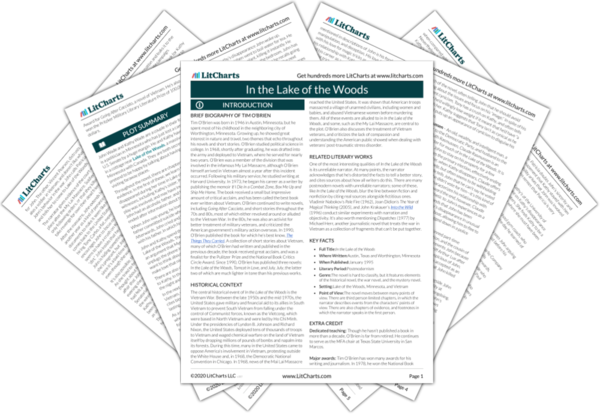When In the Lake of the Woods was first published, many readers were irritated that Tim O’Brien didn’t solve the mystery he’d laid out: he didn’t reveal what happened to Kathy Wade. While it’s true that there’s no way to determine to a certainty what happened, this shouldn’t be seen as a fault of the novel: In the Lake of the Woods is largely about mysteries without solutions. As O’Brien says several at several points, life itself is a mystery without a solution—put another way, there’s always more mystery than certainty in a person’s life. On one hand, O’Brien presents John Wade, Kathy, and the other characters as puzzles. It takes us half the novel, for instance, to learn that John’s father killed himself when John was a teenager. And even when we learn this, we sense that there’s an even bigger secret in the form of John’s relationship with his father—a relationship which O’Brien can try to convey in all of its complexity, but ultimately can’t. On the other hand, O’Brien’s novel is about appearances, and, more often than not, the appearance of total goodness: charm, charisma, politeness, kindness, etc.:
The most troubled characters in In the Lake of the Woods are the ones who seem the most “normal” to other people. John’s father, a depressed alcoholic, is a beloved figure in his neighborhood, and John himself takes up magic, and later politics, to make himself seem likable. It’s almost as if the appearance of wholesomeness and likability are evidence of some deep-down, unknowable sadness or neurosis.
This tension between what is seen and what lies beneath is the essence of magic. As O’Brien argues throughout his book, the “charm” of magic is that the audience knows things aren’t what they seem (the magician isn’t actually making the rabbit disappear), and yet wants to believe that things are what they seem. The tension between appearance and truth is more interesting and satisfying than truth by itself could ever be—it wouldn’t be any fun to know the secret behind every magic trick, after all. The psychology of magic helps explain why Kathy stays with John even after she senses that something isn’t quite right with him—she enjoys the mystery of his personality. In much the same way, this is why O’Brien doesn’t provide a solution to the mystery of Kathy’s disappearance. The solution by itself couldn’t possibly be as entertaining as all the possible explanations for how she disappeared, taken together.
Enjoying the mystery more than the solution can be dangerous—for instance, by accepting the “mystery” of John’s personality, Kathy accepts and in some ways encourages his trauma and neurosis. And yet O’Brien the author can’t entirely disavow this way of dealing with mystery, since he treats the mystery of Kathy’s disappearance in much the same way. Ultimately, appearance and the unknowable reach a stalemate. It’s impossible to know everything about everyone. In the absence of perfect information, humans make up scenarios and possibilities to explain what they don’t understand. The result is a feeling of “magic”—failing to understand a phenomenon and enjoying the sense of uncertainty. Rather than judge this feeling as being entirely “good” or “bad,” O’Brien suggests that it’s a part of human nature.
Appearance, the Unknowable, and Magic ThemeTracker

Appearance, the Unknowable, and Magic Quotes in In the Lake of the Woods
You know, I think politics and magic were almost the same thing for him. Transformations—that’s part of it—trying to change things. When you think about it, magicians and politicians are basically control freaks.
He talked about leading a good life, doing good things telling the full truth. Politics was manipulation. Like a magic show: invisible wires and secret trapdoors.
Audiences want to believe what they see a magician do, and yet at the same time they know better and do not believe. Therein lies the fascination of magic to modern people. It is a paradox, a riddle, a half-fulfillment of an ancient desire, a puzzle, a torment, a cheat and a truth.
Double consummation: A way of fooling the audience by making it believe a trick is over before it really is.
Curiously, as he worked out the details, Wade found himself experiencing a dull new sympathy for his father. This was how it was. You go about your business. You carry the burdens, entomb yourself in silence, conceal demon-history from all others and most times from yourself. Nothing theatrical … and then one day you discover a length of clothesline. You amaze yourself.
















